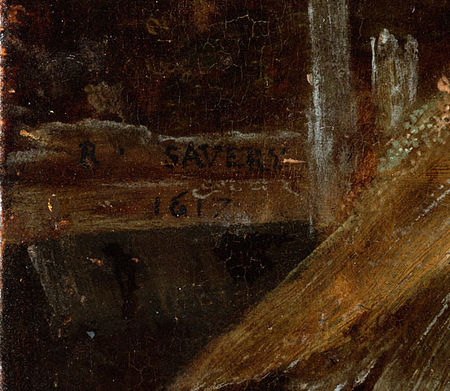New acquisition from the J. Paul Getty Museum: Landscape with the Temptation of Saint Anthony, 1617 of Roelandt Savery
Roelandt Savery, Flemish, Landscape with the Temptation of Saint Anthony, 1617, Oil on panel, 19 5/16 x 37 in. 2008.73. The J. Paul Getty Trust © J. Paul Getty Trust
Transforming the theme of the temptation of Saint Anthony into a celebration of nature's magnificence, Flemish landscape and still life painter Roelandt Savery depicted the hermit Anthony reading a Bible--oblivious to the antics of numerous fantastic demons--while seated in a rustic cell. His wooden hut is nestled in a majestic and thickly wooded alpine wilderness, the true subject of Savery's painting.
As a child, Roelandt Savery moved to Haarlem from the southern Netherlands. By 1591 he was probably studying with his brother Jacob and the artist Hans Bol in Amsterdam. For much of his career Savery traveled widely, working for Rudolf II in Prague and then Emperor Matthias, before settling in Utrecht in 1619.
The nearly ten years Savery worked for Rudolf II, beginning about 1603, were decisive. He traveled in Prague, Bohemia, and to the Tyrol, where he drew mountain scenery. These drawings provided source material for the rest of his career. While Savery's paintings recall Jan Brueghel the Elder's works, Savery's style is more archaic. He also incorporated the exotic animals that he studied closely in Rudolf II's menagerie. He must have even seen a now-extinct dodo bird, for it appears in one of his pictures.
Savery's works played important roles in the development of several genres: floral still lifes, paintings of cows and other animals, cityscapes, and landscapes. His mountain scenes with precipitous rocks and waterfalls influenced Dutch landscape painters such as Allart van Everdingen, Herman Saftleven the Younger, and Jacob van Ruisdael. According to biographer Arnold Houbracken, Savery died insane. www.getty.edu
Artist's signature © J. Paul Getty Trust
Roelandt Savery
Savery, Roelandt (b Courtrai [Kortrijk], ?1576; d Utrecht, 25 Feb. 1639).
Flemish-born Dutch painter, draughtsman, and etcher of landscapes, animal subjects, and still-life, the most distinguished member of a family of artists. He grew up in Amsterdam and in 1619 settled in Utrecht, but he is best known for his association with Prague, where he worked for the Emperor Rudolf II (see Habsburg) from 1603 to 1613. Rudolf's famous menagerie allowed him to study in detail the exotic animals that became the trademark of his work. He painted and drew creatures such as pelicans, ostriches, camels, and the now extinct dodo, and was one of the first artists in the Netherlands to produce pictures of animals alone. His favourite subjects, however, were Orpheus and the Garden of Eden, which allowed him to include any number of colourful beasts. Savery's bright and highly finished style is similar to that of Jan ‘Velvet’ Brueghel, but is somewhat more archaic. His rare flower paintings are sometimes of outstanding quality, and with Bosschaert (likewise Flemish born) he was an influential early exponent of this genre in Holland. Houbraken says that Savery died insane. His brother Jacob Savery (b Courtrai, c.1565; d Amsterdam, 1603) was a painter, draughtsman, and etcher. He was influenced by Pieter Bruegel and numerous drawings formerly attributed to Bruegel are now considered to be deliberate forgeries by Jacob; other ‘Bruegel’ drawings are thought to be by Roelandt. The Oxford Dictionary of Art

/https%3A%2F%2Fprofilepics.canalblog.com%2Fprofilepics%2F1%2F0%2F100183.jpg)
/https%3A%2F%2Fstorage.canalblog.com%2F03%2F02%2F119589%2F96711876_o.jpg)
/https%3A%2F%2Fstorage.canalblog.com%2F11%2F31%2F119589%2F94773502_o.jpg)
/https%3A%2F%2Fstorage.canalblog.com%2F20%2F83%2F119589%2F94772815_o.jpg)
/https%3A%2F%2Fstorage.canalblog.com%2F26%2F72%2F119589%2F75604929_o.jpg)
/https%3A%2F%2Fstorage.canalblog.com%2F59%2F60%2F119589%2F26458628_o.jpg)





/http%3A%2F%2Fstorage.canalblog.com%2F91%2F49%2F119589%2F76368760_o.jpg)
/http%3A%2F%2Fstorage.canalblog.com%2F79%2F85%2F119589%2F74383196_o.jpg)
/http%3A%2F%2Fstorage.canalblog.com%2F40%2F65%2F119589%2F74195559_o.jpg)
/http%3A%2F%2Fstorage.canalblog.com%2F34%2F75%2F119589%2F73821448_o.jpg)